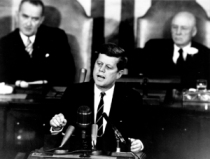I believe that this nation should commit itself to achieving the goal, before this decade is out, of landing a man on the moon and returning him safely to the earth.
John F. Kennedy
50 years ago today, John F. Kennedy charged congress—and the nation—with the most ambitious goal of the 20th century: putting a human being on the moon. This idea galvanized the nation for years to come. Many still look to the accomplishment of this goal on July 20, 1969 as one of America’s greatest achievements.
How did this simple statement drive such a monumental effort? I believe it met—and exceeded—all the criteria of a SMART goal:
1. Specific: He completely avoided ambiguity. When speaking of the future we tend to use vage speech. Kennedy left no wiggle room. He even included bringing the person home (that’s the tough part).
2. Measurable: The Space Race had been in full swing since the Soviets launched Sputnik four years earlier. The US needed a quantifiable goal—a way to judge and determine success.
3. Ambitious: You’ve got to stretch yourself, inspire yourself, push the envelope of what you think is possible. This is where purpose and passion are forged. Landing someone on the moon still fires the limits of our imagination.
4. Realistic: Counter to the previous criterium, your goal must remain in the realm of possible, albeit on the edge. Putting someone on the moon in the 1960’s would be difficult, but doable.
5. Timeline: “…before this decade is out…” Setting a time limit is crucial. it focuses and intensifies your work, giving you something to drive toward. Otherwise there’s no urgency.
What are you shooting for—what’s your moon?
